VAST Error Codes And How to Fix Them!
VAST (Video Ad Serving Template) is a script that allows communication between video players and ad servers. Publishers can give details to the video player about the necessary parameters of ads and how they should be displayed.
VAST has been a standard for serving and tracking video ads, but VAST errors signal about problems in these ads and can bring extra hassle for publishers when dealing with them.
Read this article to learn about all of the most common VAST errors and how to prevent or solve them!
What are VAST Errors?
VAST errors indicate malfunctions between the ad server and video player communication due to wrong ad sizes, missing information, or other technical issues.
They can be divided into “fatal” and “potentially non-fatal” errors.
How Can I Create a VAST Error Report?
Here are 8 steps on how to create a VAST error report through Google Ad Manager:
- First, navigate to Reporting → Report and click “New report”.

- Set the type of report to Historical with a date range.
- Click on Filters (optional):
- Click on the Request type.
- Select is any of.
- In the search field, type or select Video Tag.
- Click Apply.
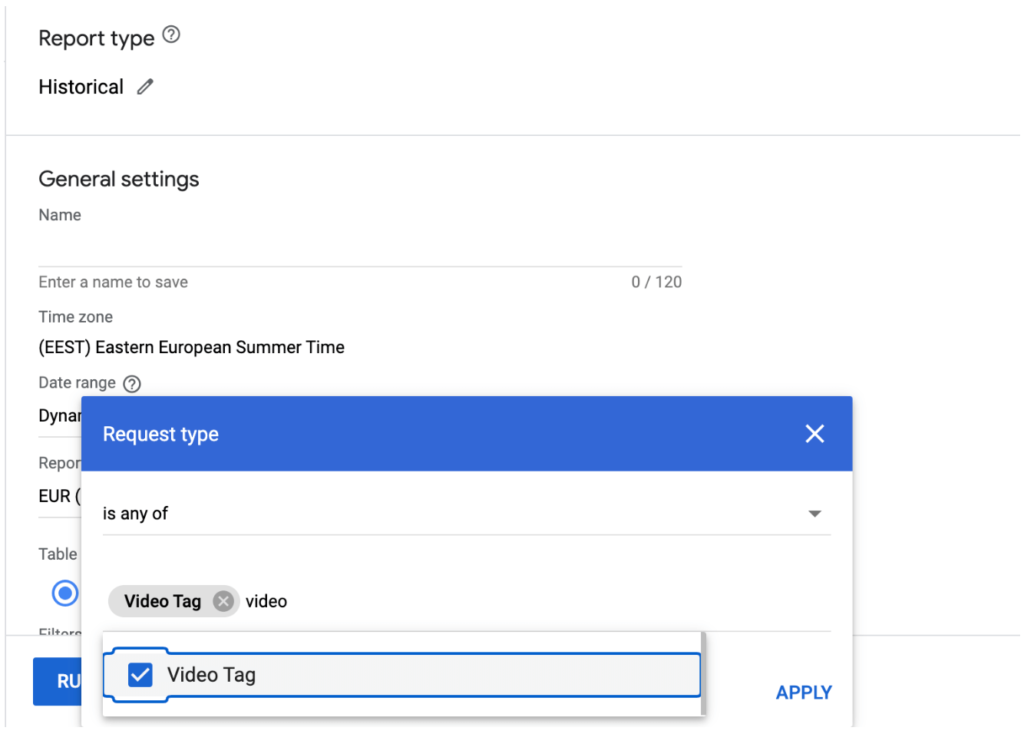
- Add the following report dimensions:
- The type of line item associated with the creative that serves the ad slot request.
- The name of the line item.
- The name of the ad unit (top-level).
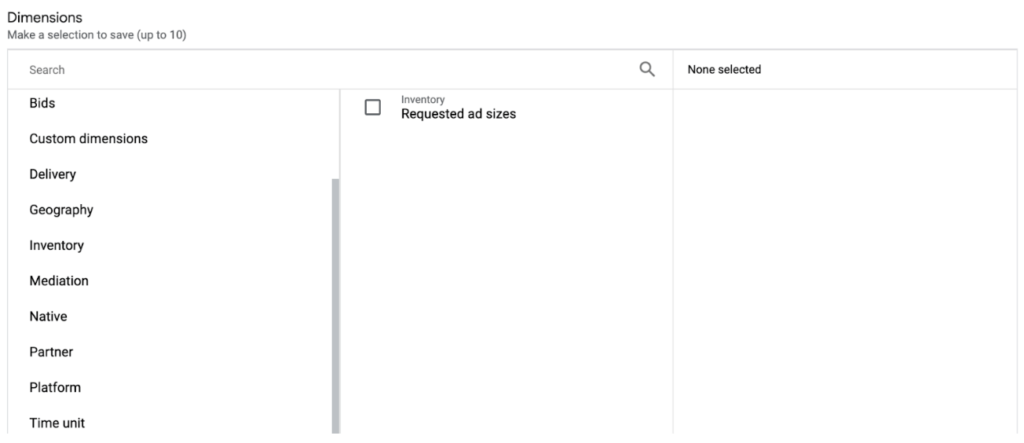
- Select the following metrics from the “Total” section:
- Total code served count–number of times Google Ad platforms (Google Ad Manager, AdSense, etc.), as well as third-party networks, responded to an ad request.
- Total impressions.
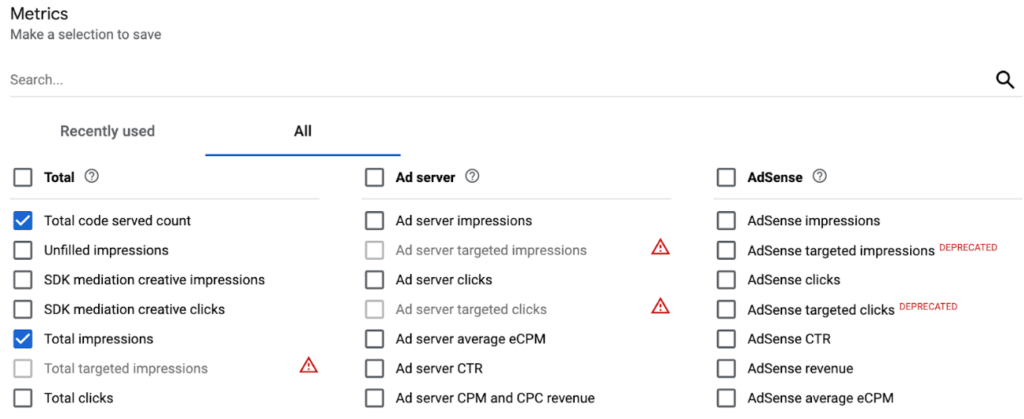
- Select Total error count from the “Video viewership” section.
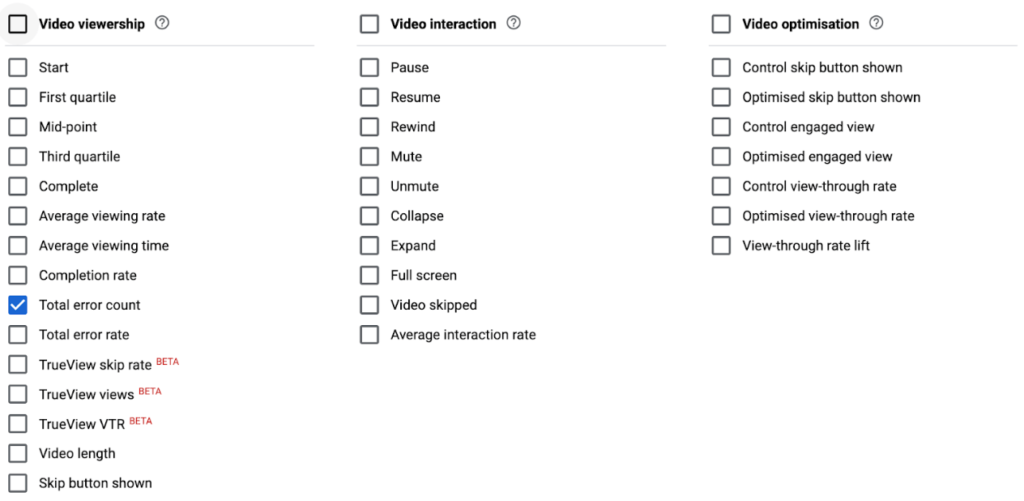
- Select all error codes in the “Video errors” section.
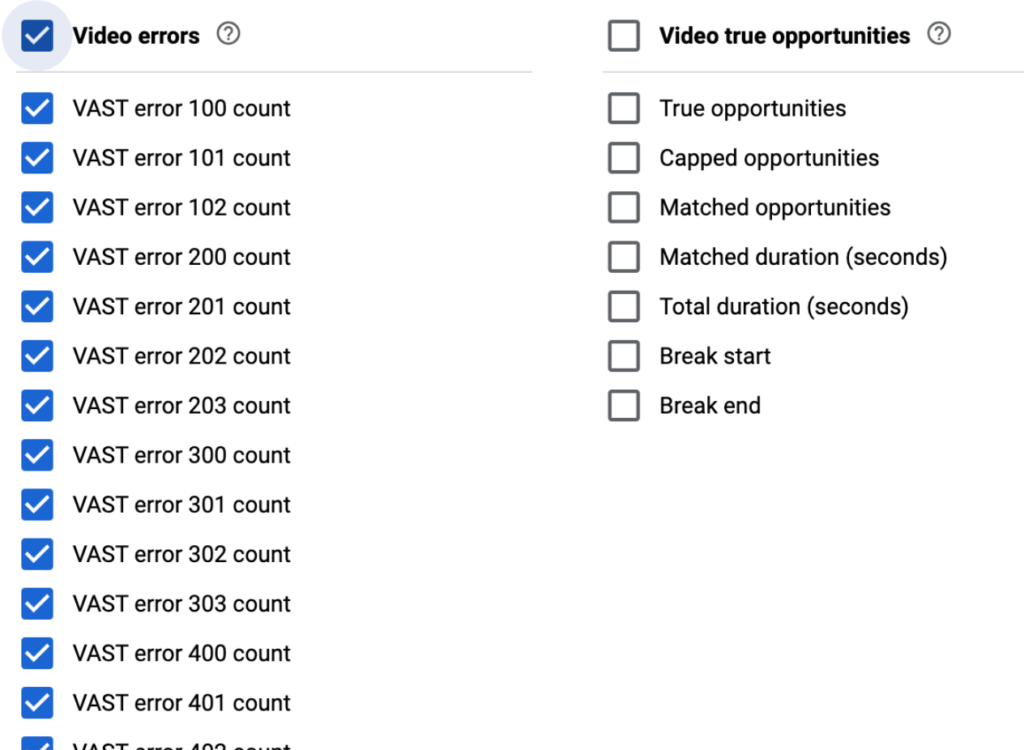
- Run your report.
It’s important to note that VAST error reporting is available for VAST 3 and up.
VAST Error Code Types And How To Fix Them
Fatal Error Codes
Fatal error codes most likely have stopped the ad from being served, leading to another ad being requested or the repeating of video content playback.
100 – XML parsing error
VAST error 100 indicates a problem with the XML document or a failed VAST ad tag URL redirect. It can be the result of a faulty buyer’s response or an invalid XML document.
XML documents are text files that contain any form of structured data, which is necessary for data transport. VAST ad tag URL is used by a player to retrieve video and audio ads.
How to solve it?
Publishers should alert the buyer to verify that the VAST XML is correctly formatted according to the IAB guidelines.
101 – VAST schema validation error
VAST error 101 indicates that the buyer’s response lacks XML’s attributes or contains unknown elements.
Some of the possible causes are shown in the image below, such as missing Ad node or MediaFile node, Duration missing, etc.

Source: IAB Tech lab
How to solve it?
Publishers should inform the buyer to assure that the VAST XML formatting contains all of the required information.
102 – VAST version of response not supported
VAST error 102 indicates that there are possible issues with the VAST version–the video player doesn’t support the bid request’s VAST version, or the exchange sends the wrong one.
There’s a possibility that the VAST doesn’t contain a version, and then it can be considered as a schema validation issue–the file is missing or has invalid information.
How to solve it?
Publishers should inform the buyer to ensure only supported VAST versions.
204 – Required ad category is missing
VAST error 204 occurs when an ad category was required but not provided.
How to solve it?
Make sure to include an ad category if it’s necessary.
300 – General Wrapper error
VAST error 300 is considered to be a general wrapper error, which occurs when the wrapper limit is reached and it isn’t actionable.
How to prevent it?
There are steps you can take beforehand to avoid this error, like conducting a review of all VAST URIs (Uniform Resource Identifier) to ensure that they’re not timing out and remain reachable.
301 – Timeout of VAST URI
VAST error 301 indicates a timeout of an unresponsive or broken URI inside a VAST creative. This could also be the fault of poor internet connection, non-optimized page, or HTTP serving to HTTPS.
How to solve it?
To solve this error publishers can check the validity of the VAST URI to make sure that it’s reachable and without any faults, and increase the video player’s timeout limit.
Also, it’s important to check the internet connection to avoid request time-out, and check if there are no protocol issues.
302 – Wrapper limit reached
VAST error 302 is displayed when the wrapper limit has exceeded. Meaning, each video player often has a specific wrapper limit, and when it’s reached, this error is likely to occur.
This error can also appear if there are too many wrapper responses received without an inline response. It might also be the cause of too many wrappers or daisy chaining–a loop of networks bouncing to one another.
How to solve it?
- Increase the wrapper limit of your video player.
- Avoid daisy chaining, as that can cause too many redirects from a video player and cancel any ad request.
303 – No ads VAST response after one or more Wrappers
VAST error 303 appears when an empty VAST response is returned. It can happen when the ad request is contained in a third-party wrapper.
If you work with third-party networks, the offered fill rate is less than 100%, and the remaining percentage portrays the chance of an error occurring.
For example, if the third-party promises 70% fill rate, then there’s a 30% chance of an error occurring.
How to solve it?
Publishers can resolve this by enabling fallback in Google Ad Manager with these 3 steps:
- Click on Admin, navigate to Video, and then click Video Settings.
- Enable Video Fallback.
- Save these settings.
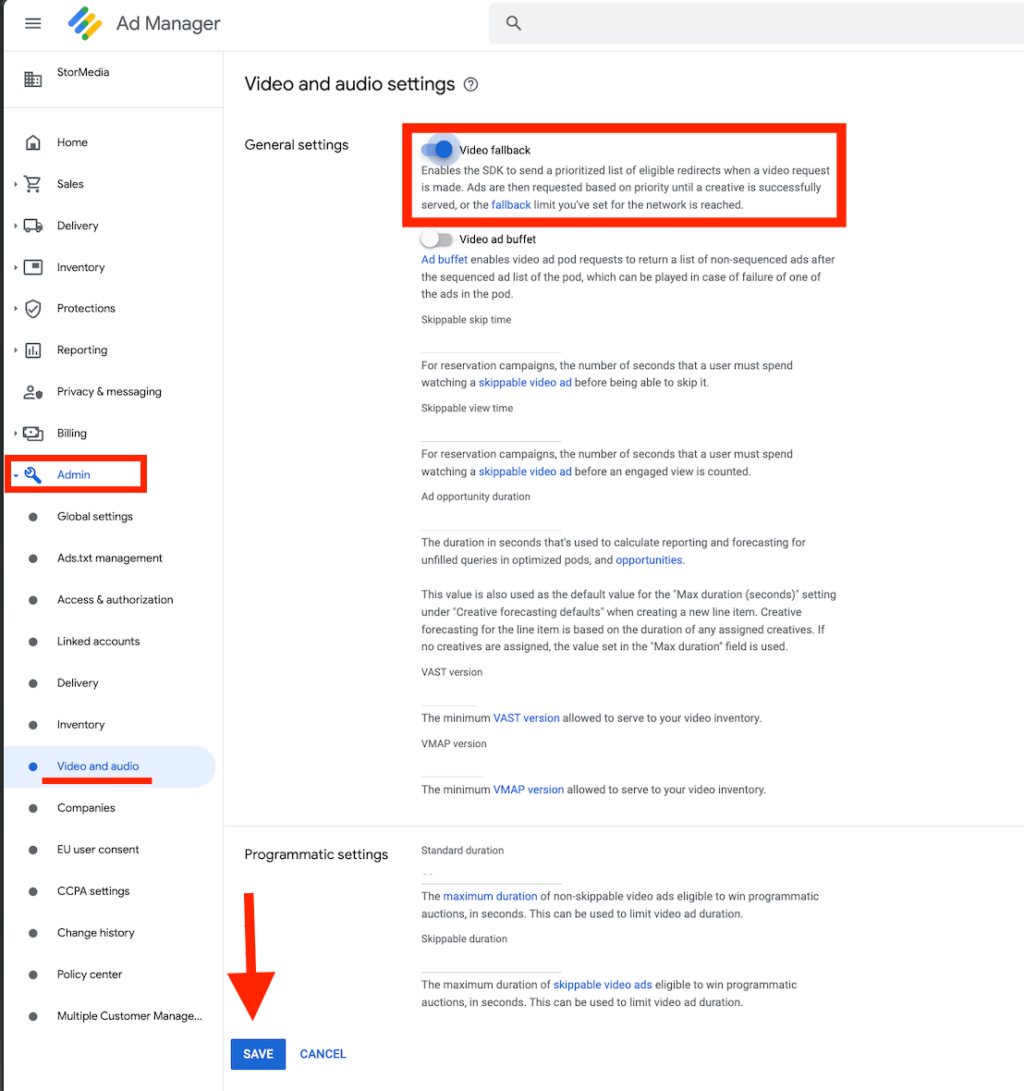
To avoid this error you should ensure that the bids being returned don’t have an empty VAST.
304 – Fetch timeout
VAST error 304 indicates that an InLine response returned ad unit failed to result in ad display within the defined time limit
How to solve it?
VAST Wrappers should be limited to five or within the defined time limit before resulting in an InLine response.
400 – General linear error
VAST error 400 indicates that the video player can’t display a linear ad (an ad that appears before, during, or after a pre-existing video content) due to an invalid MediaFile format, the browser’s autoplay restriction, or a different unknown reason.
Linear ad example

How to solve it?
Publishers can try one of these 3 steps:
- Check if the video player has any issues.
- Enable video player detection for restricted autoplay.
- Contact the buyer, who must check that the VAST response is returning a valid creative.
401 – File not found
VAST error 401 indicates that a file can’t be found from the MediaFile URI.
How to solve it?
Publishers should alert the buyer, who should ensure that all MediaFile URIs in the VAST response return a valid creative.
402 – Timeout of MediaFile URI
VAST error 402 resembles a timeout that can occur with a problematic media file. If the ad creative takes a lot more time to load, then there’s a high chance that this error might appear.
VAST ad unit contains a creative that could have problems like large size and platform incompatibility. This error can be caused by low bandwidth or poor website ad implementation.
How to solve it?
Publishers can optimize their website layouts to increase their page loading speed. You can ease this process by partnering with a monetization platform, like Setupad.
More possible solutions are increasing the video player’s timeout limit, and adjusting the bitrate serving specifically for mobile devices.
403 – Unsupported MIME types for all MediaFiles
VAST error 403 indicates that there have been unsupported MIME types for all available MediaFiles (e.g. WebM on iOS). This error is more common on mobile devices.
It can also indicate that the wrong creative type attempted to play.
How to solve it?
Publishers should ensure that the creative format is supported by the video player, and buyers should ensure that all returned creatives approve the video format in the bid request.
405 – Problem displaying MediaFile
VAST error 405 occurs when a problematic creative is returned. Creatives can fail because of transcoding-related reasons, such as a mismatch between the MIME type and the video file type, or a CORS issue on the creative’s CDN.
How to solve it?
Publishers should alert the buyer, who must ensure accurate creative MIME types and CDN configurations.
406 – Missing required mezzanine file
VAST error 406 occurs when a VAST response is returned without the required mezzanine file.
Publishers that rely on SSAI (server-side ad insertion) or ad-stitching require mezzanine files to generate higher-quality videos.
How to solve it?
Publishers should alert the buyer to check if the mezzanine file is included in the response.
407 – Mezzanine is in the process of being downloaded for the first time
VAST error 407 indicates that mezzanine is in the process of being downloaded, which can take up to several hours. Until then the ad will not be served.
How to solve it?
This error will automatically stop once the mezzanine download and transcoding is finished.
408 – Conditional ad rejected
VAST error 408 occurs when the ad returned in the VAST response is rejected.
How to solve it?
Publishers should alert the buyer, who must ensure that the VAST response only has approved creatives. Ad creative hosts (advertisers or agencies) should be aware of rejections.
409 – Interactive unit in the InteractiveCreativeFile node was not executed
VAST error 409 indicates that a creative defined in the InteractiveCreativeFile node doesn’t execute.
How to solve it?
Publishers should alert the buyer, who must ensure that the returned interactive creatives play successfully when requested.
410 – The verification unit in the Verification node was not executed
VAST error 410 occurs when the code in the AdVerification node (a feature of VAST 4) doesn’t execute.
How to solve it?
Publishers have to alert the buyer, who should check that the code is implemented according to the verification vendor’s specifications.
500 – General NonLinearAds error
VAST error 500 indicates that the video player is unable to display a non-linear ad for an unknown reason.
Non-linear ad example
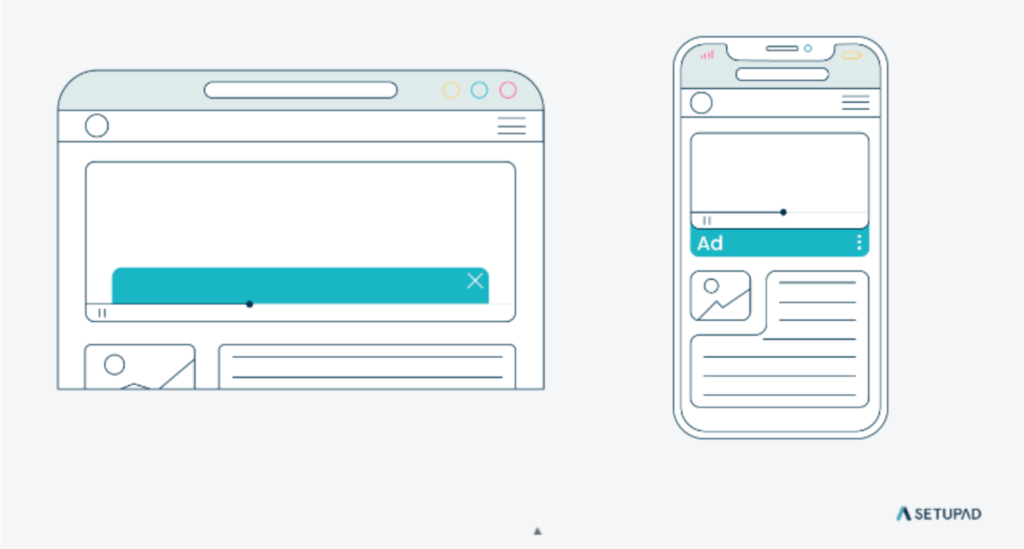
How to solve it?
Publishers should check for any video player issues, or alert the buyer, who must ensure that the VAST response returns a valid creative.
501 – Unable to display NonLinear Ad
VAST error 501 occurs when a non-linear ad fails to play because the creative’s dimensions are larger than the creative display area. It can also be the result of using CSS styles to set the video content’s dimensions.
How to solve it?
Publishers should ensure that the set width and height match the display area. Instead of CSS styles, use HTML attributes to set video content’s dimensions.
502 – Unable to fetch NonLinearAds/NonLinear resource
VAST error 502 occurs when the buyer’s response returns a non-linear ad that fails to return a valid creative.
How to solve it?
Publishers should alert the buyer, who must ensure that valid creatives are returned in the non-linear ad response.
503 – Could not find NonLinearresource with a supported type
VAST error 503 occurs when a creative size is bigger than the player size, or it indicates an improper media type.
How to solve it?
Publishers should check if the video player accepts requested creative sizes and media types.
900 – Undefined VAST 3 error
VAST error 900 is the result of an unknown VAST 3 error, which can stop the ad request.
How to solve it?
Publishers should alert the buyer, and work together to troubleshoot the exact issue.
901 – General VPAID error
VAST error 901 can be the result of:
- SSP VPAID wrapper timeout;
- SSP VPAID wrapper not buying;
- VPAID creatives required insecure mode;
- An Authorized Buyers “IMA adapter” tag is used with IMA SDK, and a VPAID ad is returned.
How to solve it?
Publishers should ensure that any VPAID requests are supported for devices and players. Use video creative profiles to control and adjust which creatives are eligible to serve.
Potentially Non-fatal Error Codes
Potentially non-fatal errors may allow the ad to continue playing, as they indicate a problem in the application but don’t result in a crash.
200 – Video player expected different ad type
VAST error 200 can occur if a video player doesn’t expect or support an ad type requested in a bid request.
For example, the player supports linear ads but receives a skippable ad.
How to solve it?
Publishers should check for trafficking errors, or alert the buyer, who should ensure that only specified ad types are sent in a response.
201 – Video player expecting different linearity
VAST error 201 can occur when the linearity in the buyer’s response doesn’t match the video player’s request.
For example, a linear ad was requested but a non-linear ad was sent in response.
How to solve it?
Publishers should ensure that the correct linearity is specified in the ad request.
202 – Video player expecting different duration
VAST error 202 can occur when the creative is returned with a different duration than specified.
For example, the actual MediaFile duration is 30 seconds, but a creative is sent with a 15 second duration.
How to solve it?
Publishers should ensure that the creative duration is set properly in Google Ad Manager.
203 – Video player expecting different size
VAST error 203 can occur when returned MediaFiles aren’t compatible with the device from which the bid request is sent. It can be the result of returning high bitrate creatives to mobile devices, which would be slow or impossible to load.
How to solve it?
Publishers should alert the buyer, who must ensure that the response includes MediaFiles compatible with different devices and technologies.
600 – General CompanionAds error
VAST error 600 occurs when a publisher is unable to display a companion ad. A companion ad is a display ad that appears around the video player and usually has a clear call to action.
Companion ad example

How to solve it?
Publishers should check for ad serving issues, or alert the buyer, who must ensure that the VAST response returns a valid creative.
601 – Unable to display companion because creative dimensions do not fit within Companion display area (i.e., no available space)
VAST error 601 occurs when the companion creative dimensions don’t fit within the companion display area.
How to solve it?
Publishers should ensure that the requested companion ad size fits within the dimension of the ad unit.
602 – Unable to display Required Companion
VAST error 602 occurs when the publisher is unable to render the companion ad creative returned in the VAST response.
How to solve it?
Publishers should check for ad serving issues, or inform the buyer, who must ensure that the VAST response returns a valid creative.
603 – Unable to fetch CompanionAds/Companion resource
VAST error 603 occurs when the buyer’s response returns a companion ad that fails to return a valid creative.
How to solve it?
Publishers should inform the buyer, who must ensure that valid creatives are returned in the companion ad response.
604 – Could not find a Companion resource with a supported type
VAST error 604 occurs when a publisher requests an unsupported creative type for the companion ad slot.
How to solve it?
Publishers should ensure that specific creative types are supported for the companion ad slot.
Best Practices to Follow to Avoid VAST Errors
To avoid possible VAST errors follow these 3 practices:
- Ensure that DSPs scan all creatives before serving the ad to save time and resolve possible issues and errors.
- Collaborate with your SSPs, DSPs, ad network, and ad servers to improve the performance of your VAST creatives or partner with a monetization platform who will take care of this.
- Implement multiple media files with varying bitrates, so the video player can choose the best one for different network connection speeds.
Conclusion
This guide includes all popular VAST errors and actionable tips to solve them. If you’re not technically savvy enough or don’t have a dedicated AdOps team, you can partner with a trusted ad provider that has video ad offering and who will solve any errors for you.
Setupad offers in-stream video ads for publishers with existing video content and a video player. If publishers don’t have video content, we offer a video player that includes demand from all our partner SSPs (Google Adx, Rubicon, etc.) If there are any errors with the player, we immediately contact the video player provider to solve these issues.


